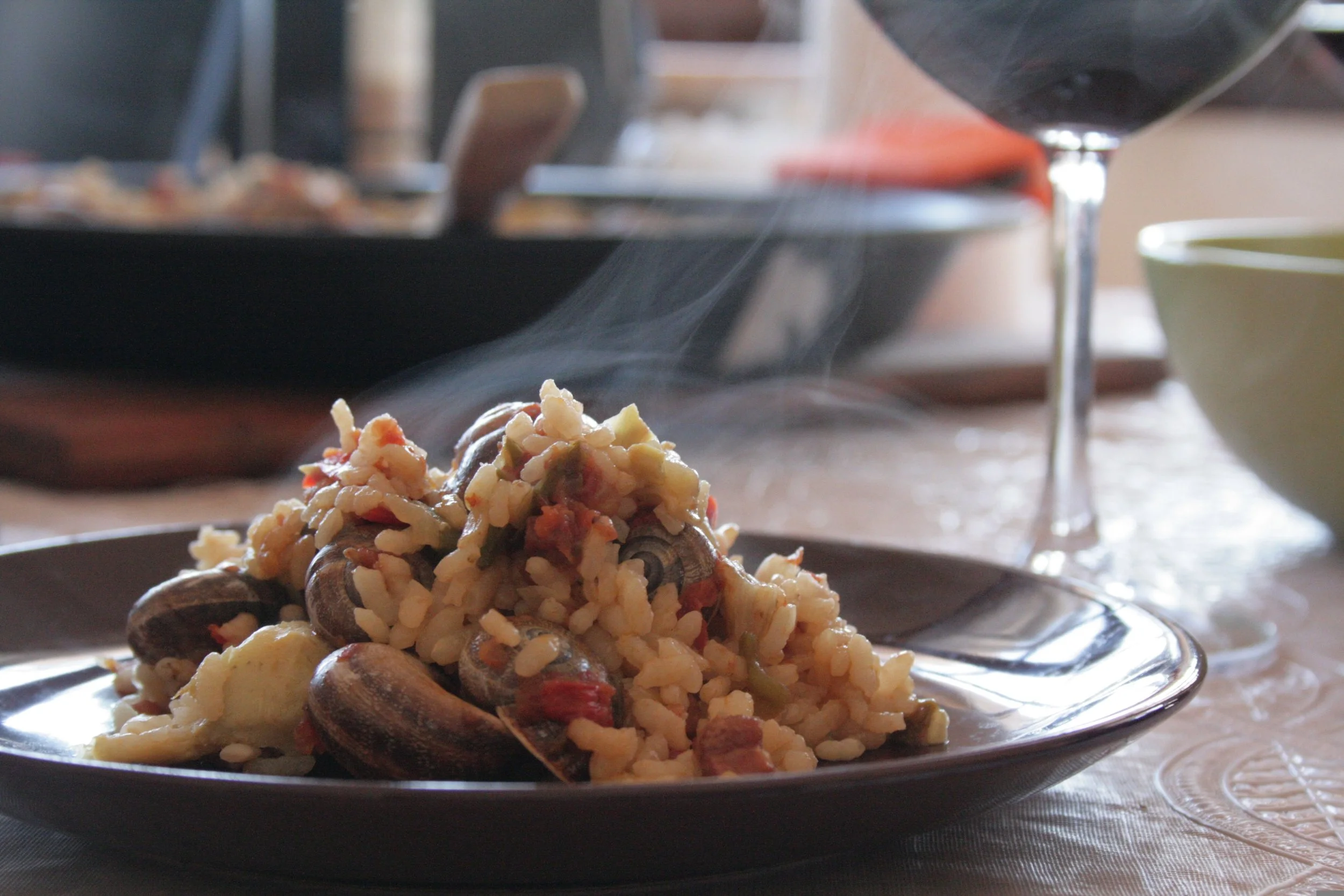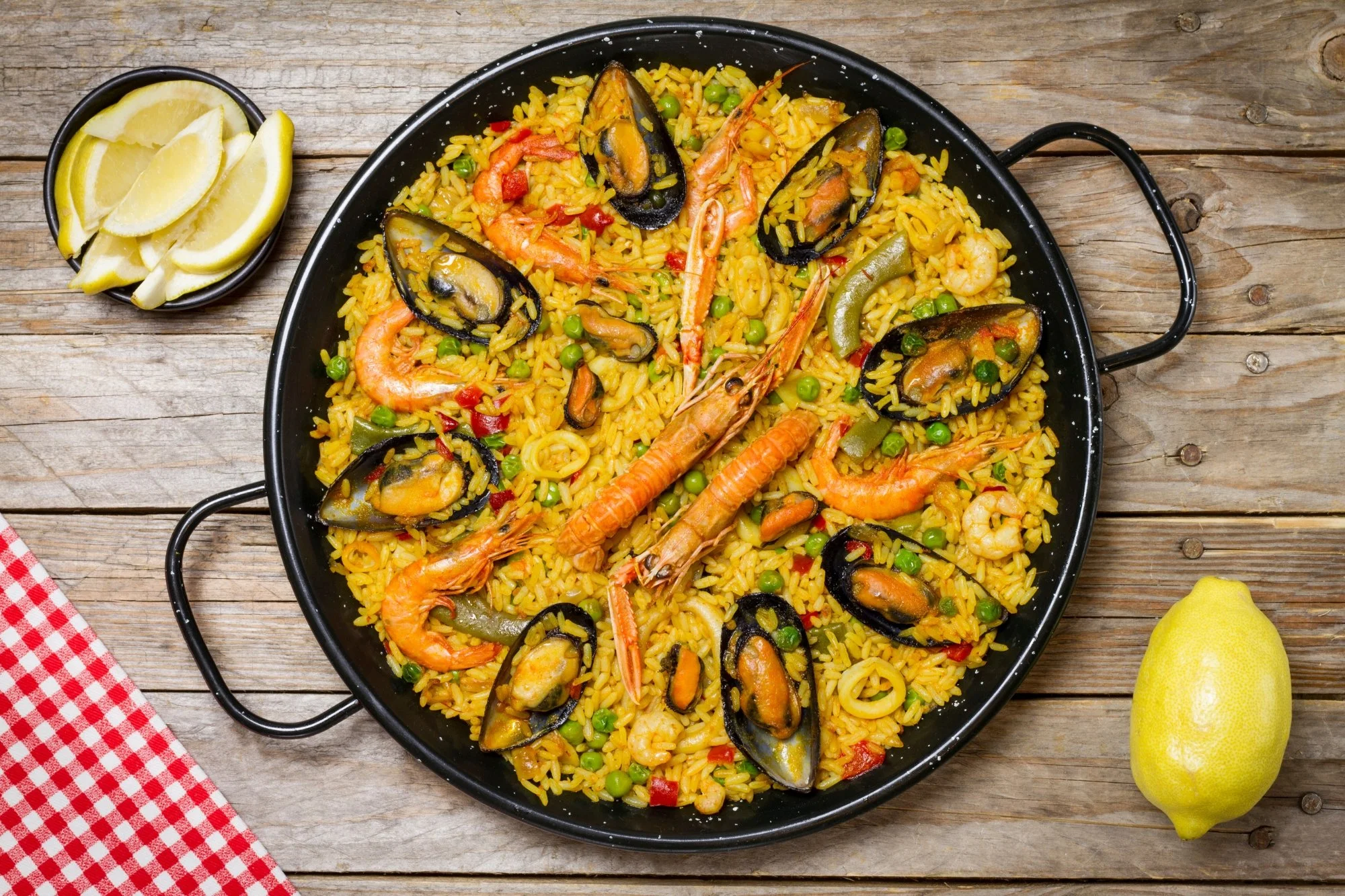Wine and Paella: Kindred Spirits
Paella served outdoors
Born as a humble dish in the Spanish countryside, paella has become an international culinary icon, anointed with its own emoji. It’s a party dish par excellence, often served on Sundays, at weddings, and during other family gatherings in Spain. “Sharing a paella,” note the authors of a 2021 study of the dish, “is synonymous with cultivating friendship, a festive celebration, a manifestation of joy.”
This celebratory, communal spirit makes wine a particularly apt beverage choice, says Liz Bokisch, co-owner of Bokisch Vineyards in Lodi, California, specializing in Spanish varietals. “You share a bottle like you share a paella pan,” she notes, unlike other drinks served individually. At the winery’s annual paella events, the sounds of wine pouring and glasses clinking, Bokisch says, make you feel immediately like you’re participating in something special.
Cakebread Cellars Executive Chef Brian Streeter echoes this sentiment and shares it at the winery’s paella cooking classes in Napa Valley, California. “The spirit of paella is centered on its role as a communal dish that’s best enjoyed outdoors with friends and family,” he notes. “Traditionally cooked over open flame, the rice becomes the star of the show. Naturally, it calls for wine, which brings the same sense of togetherness and enhances the experience around the table.”
“When we pair wine with a dish like paella, we think beyond flavor to curate a moment,” Streeter adds. “Every shared meal deserves to be savored, and wine helps you do exactly that.”
A Brief Paella Primer
Paella pans
Paella gets its name from the wide, shallow pan in which it’s made. The rice—short- or medium-grained—cooks in a thin, even layer, which encourages the desired finish: dry, separate grains with rich flavor, and, in many cases, a crisp, caramelized layer known as socarrat. Beyond the classic paella Valenciana, with its strict rules, the dish takes many forms. In Spain, seafood dominates in coastal areas, while inland, Mediterranean garden and scrubland ingredients abound—from bell peppers, green beans, and artichokes to rabbit, rosemary, and snails.
According to El gran libro (secreto) de la paella by Vicente Rioja. Alba Editorial, 2025, all paellas have several flavor-building blocks, starting with the main ingredients—the meats and vegetables, which are browned separately in olive oil. The classic paella sofrito—tomato cooked down to a savory paste with olive oil—adds depth. Depending on the type of paella, the sofrito may also include garlic, onions, and green peppers. A few spices and herbs—usually saffron, rosemary, and sometimes pimentón—add nuance. When cooked traditionally, over fire, paella also absorbs hints of smoke and even citrus notes if orange-tree wood is used. The rice soaks up all of these flavors, which are often subtle, yet masterfully harmonious.
General Guidelines for Pairing Wine with Paella
Paella and wine
Given this complexity and subtle equilibrium, and the effort it takes to achieve, you don’t want a drink that overpowers or competes with the flavors, but rather something that complements and even elevates them.
“Wine is a great pairing for paella—and any rice dish, really,” explains Jessica Salyer, Wine Director at Cúrate in Asheville, North Carolina. “[Wine] can complement the savory flavors and cut through rice’s natural richness and starch.”
To choose a good match, Salyer focuses on the main ingredients and the stock. “For seafood and shellfish-based arroces, I prefer a wine with crispness and acidity, as well as some good salinity. For a more earthy dish, I look for a variety that complements that earthiness, usually a red with medium body and ripe red fruit.”
Streeter takes a similar approach: “When I’m thinking about wine pairings for paella, I always start with the ingredients. What kind of protein are we working with? Is there a smoky element? How intense are the spices? That gives me a roadmap to work within.”
For all types of paella, Michael Pope—sommelier and founder of Vine Travel, a boutique Spanish wine tour agency—recommends a traditional-method sparkling wine. In the Utiel-Requena DOP wine region of Valencia, winemakers often serve a dry cava with rice dishes, he says. With complexity from lees aging, acidity, and a refreshing sensation from the bubbles, “it ticks off all the boxes.” If you opt for cava, be sure it’s dry—preferably extra brut or brut nature—rather than sweet, Pope advises. Crémants (dry, traditional-method sparkling wines made in France outside the Champagne region) and South African Cap Classiques are other good options.
Pairing Ideas for 5 Different Types of Paella
Paella Valenciana
Paella Valenciana
The ingredients of this classic paella spark heated debate among purists. To settle the matter, researchers surveyed over 300 households across Valencia and shared their results in the International Journal of Gastronomy and Food Science. They identified 10 ingredients used over 90% of the time: rice, olive oil, saffron (or yellow coloring), tomato, chicken, ferraduras (flat green beans), garrafó (butter or lima beans), rabbit, salt, and water. Ingredients not used at all—including chorizo and peas—are fine in other rice dishes, just don’t call them paella Valenciana, the scholars wrote. “Perhaps we should call those other dishes, alternative and equally respectable, ‘something with rice,’ or simply ‘paella. ’”
Thankfully, wine pairings for the dish are not so contentious. “That’s where I’d definitely go with a cava,” Pope offers, without hesitation. It rounds out all the flavors, including the gaminess of the rabbit and the green beans, which can be difficult to pair with, he says. He recommends a brut nature or extra brut cava or another dry, traditional-method sparkling wine, like a Crémant de Loire. “It’s a very easy choice if you’re stuck for a pairing.”
Red wines can also work well with the paella Valenciana. Streeter suggests a medium-bodied red with bright fruit and soft tannins, like a garnacha (grenache in French) or pinot noir. “They offer enough structure to stand up to the meat and beans without overwhelming the more delicate flavors,” he says. Bokisch also recommends garnacha with a profile like the one her winery makes. “It has very nice spice blended with lighter fruit qualities that play well with the soccarat,” she says. If the rabbit is on the gamier side, she’d go for a tempranillo. One to consider, Altos De La Guardia Tempranillo.
At Cúrate, Salyer recommends bobal—a red Valencian grape with high acidity and tannins. “Bodega Mustiguillo has some of my favorite bobal wines that are a perfect choice.” Mustiguillo Finca Terrazo is a 100% bobal wine.
Arroz Negro
Arroz Negro
Made with squid or cuttlefish ink, arroz negro, or “black rice,” has a striking color and rich umami flavor. It can get a little heavy sometimes, so you want something that balances it out and cleanses the palate, Bokisch says. She recommends a sparkling albariño with crisp acidity. “It’s fresh and bubbly, and it has that zippiness of the citrus that’s going to complement [the dish].”
Along similar lines, Streeter suggests a sauvignon blanc. “It’s a zesty white with citrus and mineral notes that cut through the richness and elevate the seafood.”
Pope recommends mineral-driven Atlantic whites, such as albariños from Rias Baixas or godellos from Valdeorres. A South African chenin blanc could also be a good option for its zesty citrus notes, he adds.
Taking a slightly different approach, Salyer recommends red Txakolina, also known as Txakolí, from the Basque Country in northern Spain. “They’re my favorite pairing when it comes to anything squid ink, especially an arroz,” she says. Made with native hondarrabi beltza grapes, red Txakolina is characterized by bright acidity. But it can be hard to find in the States, Salyer notes, so rosé is another excellent choice.
Seafood Paella
Seafood paella
More subtle than arroz negro, seafood paella typically features a combination of shellfish—shrimp, squid, mussels, and clams—with depth of flavor from the sofrito. Crisp whites with high acidity and citrus notes are a natural match, experts say.
“Seafood paellas tend to crave something bright and citrusy,” Streeter explains. “Something like a sauvignon blanc is a go-to there. It has the acidity to cut through the richness and a minerality that plays nicely with shellfish or calamari.”
Bokisch would reach for an albariño, ideally fermented in stainless steel. Picpoul de Pinet is another good choice, Pope says. Read more about Picpoul de Pinet.
Vegetable Paella
Vegetable paella
The ingredients in arroz con verduras (rice with vegetables) vary with the seasons. In the south-eastern Murcia region of Spain, famed for its garden bounty, common ingredients include artichokes, green beans, bell peppers, spring garlic, and cauliflower. It sometimes features salt cod, for flexitarians.
“While artichokes can be difficult to pair with,” Salyer notes, “I always reach for a sparkling cava or fino sherry. The dryness and effervescence of these choices are a great pair for earthy, vegetal flavors, and will brighten up on the palate.”
Pope agrees that vegetables in general, and artichokes in particular, aren’t the easiest to pair with. He recommends a sauvignon blanc with distinct vegetal flavors, such as one from New Zealand. One to consider, the award-winning Babich Organic Sauvignon Blanc. Or a verdejo from Rueda for its bright acidity. He says a light red could be a good choice here, too, such as a mencía from Bierzo, or an Oregon pinot noir—something that’s more on the berry and fresh fruit side, rather than anything too jammy.
Bolder white wines can also be a good pairing. Streeter recommends a chardonnay with some body and freshness, especially if salt cod is included. “I’d look for a style that’s not too oaky, like our Napa Valley Chardonnay, that has enough roundness and body to complement the roasted vegetables and savory elements in the dish.”
Liz Bokisch would reach for her vineyard’s verdejo because they do 24 hours of skin contact, extracting additional tannin, aroma, and flavor. “It has a lot of texture to complement the vegetables,” she says.
Chicken Paella
Chicken paella
As chicken has a more delicate flavor than other meats, you want a wine that complements the particularly subtle harmony of this paella—the browned poultry, sofrito, and spice notes—without overpowering it. “With arroz con pollo, you’re getting some smoky, savory flavors but not too much weight,” Streeter notes. He recommends a dry rosé like Cakebread Cellars’ Vin de Porche. “It has just the right balance of fruit, acidity, and structure to tie all those flavors together and keep the dish feeling vibrant.”
Light, fruity reds are also a good choice. Bokisch would pour a light, fruity Spanish red blend, like her vineyard’s Trencadis, to avoid overwhelming the chicken. Pope recommends a very young tempranillo from Rioja, medium-bodied but fruity with a bit of acidity, or a gamay from Beaujolais that’s light, red berry-forward, and lively.
Salyer recommends a garnacha from Spain’s Sierra de Gredos region. “Here, you get a delicate style of garnacha that still has the tannin to complement the chicken and spices.”








